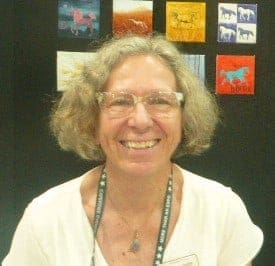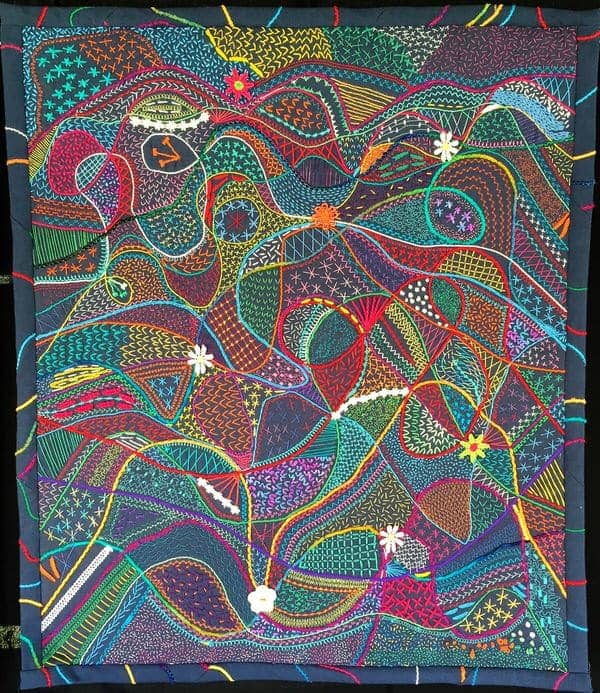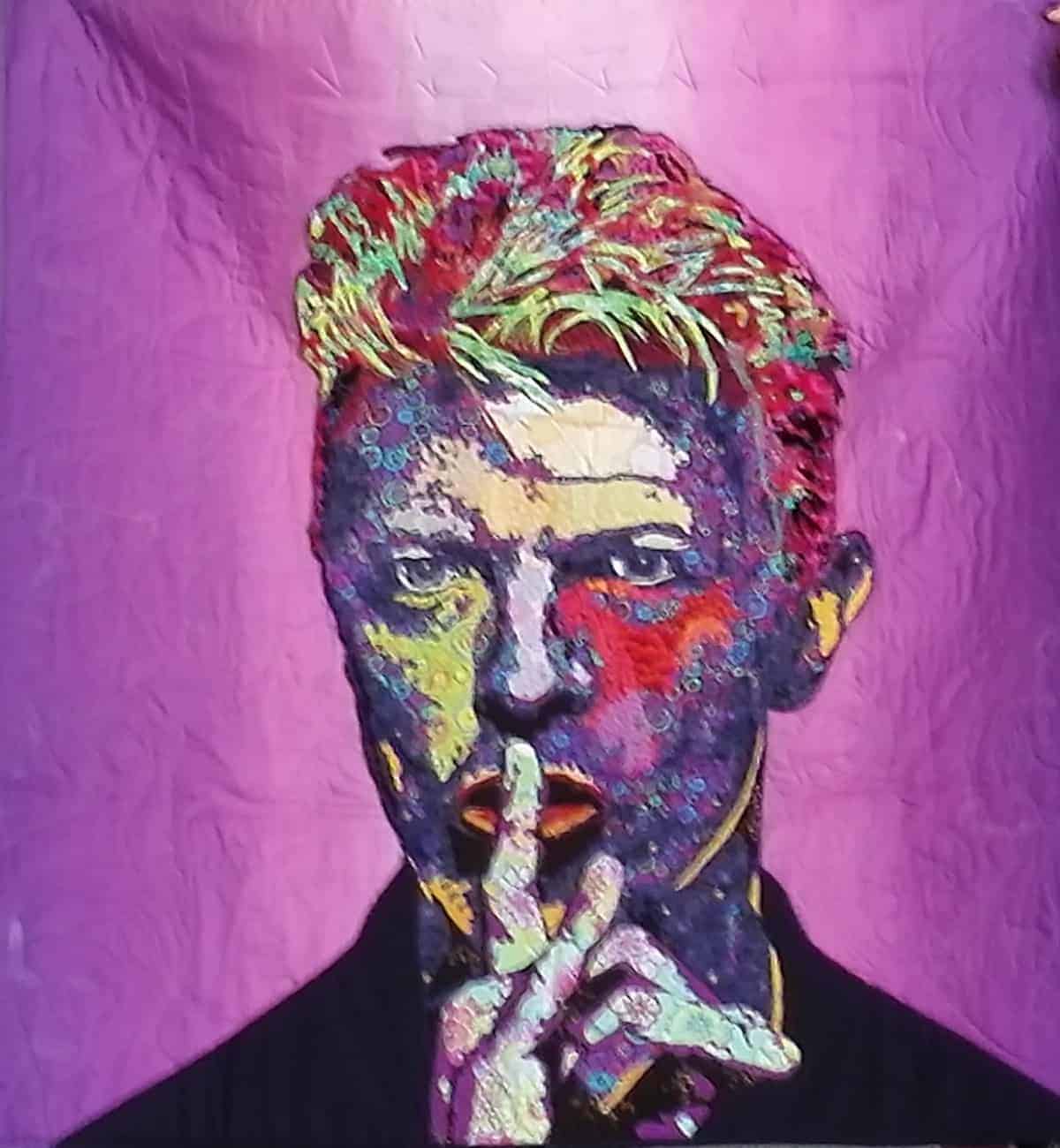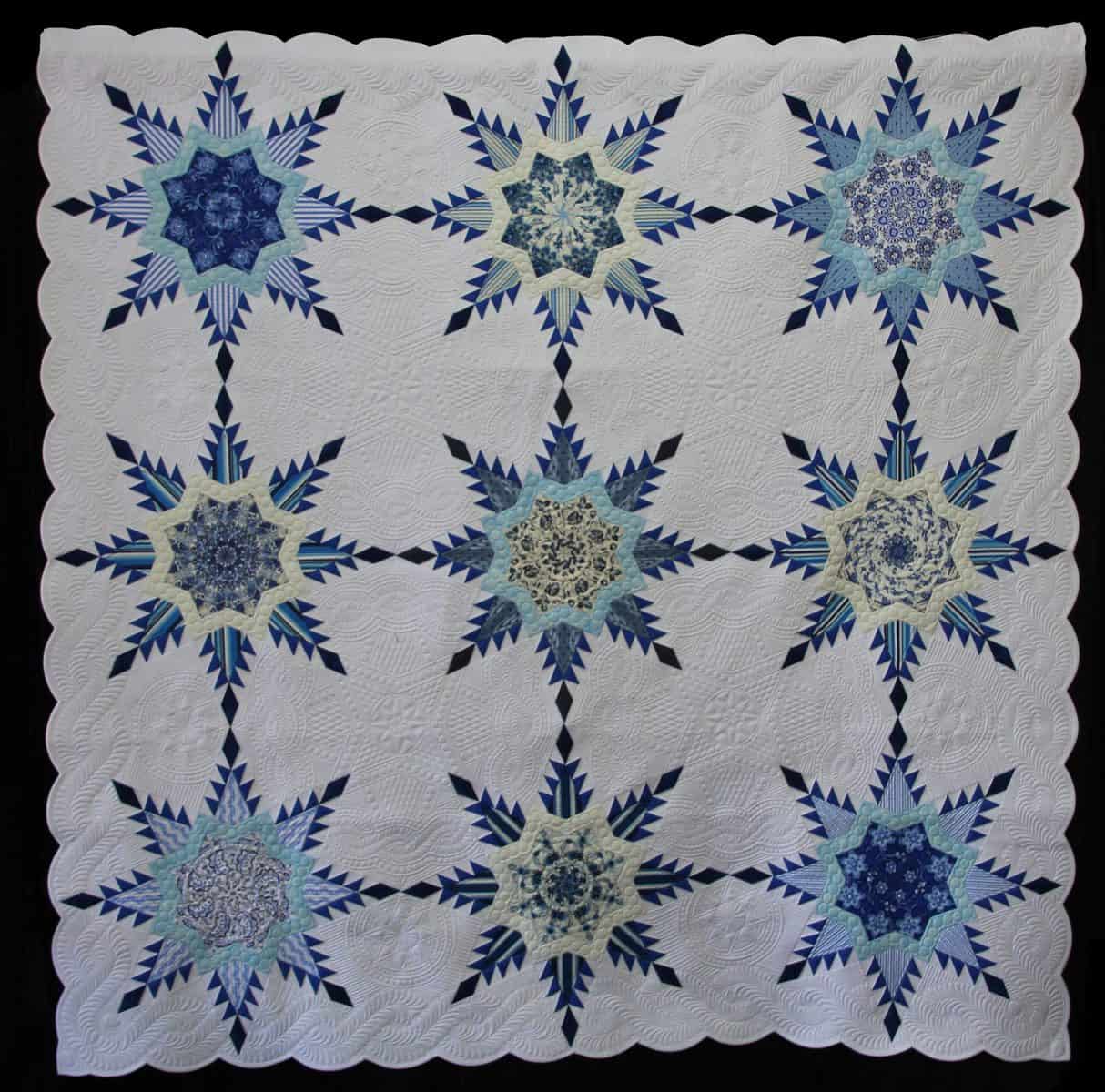Jurying quilts for a travelling exhibition is an interesting and challenging task – previously I have judged for QQ; various affiliated groups and the Redcliffe Show. There is a difference between judging and jurying, and some overlaps too. When judging quilts, we are looking for excellence in all aspects of the work, and we are choosing the most outstanding pieces in order, i.e the best and the runners-up. With jurying for an exhibition, one must consider, naturally, those things but more importantly one is also looking at how the quilts will present as a whole, and how they will best reflect the intent of the exhibition – in this case, a comprehensive representation of 2QAQ work.
The mechanics of the process is fairly straightforward. The photos of the quilts, a detail of each along with an artist statement reflecting the artist’s intent and ideas to accompany each photo, were loaded on to a USB stick and posted to me. From the photos and statements my role was to choose suitable artworks that would showcase the work being produced by Queensland Quilters Art Quilters; works that would sit together well, showing artistic styles, techniques, originality, workmanship and diversity of subject. This was no easy task, and took time, believe me!
Photographs: Assessing work from photos is always going to be somewhat difficult, given that photos don’t always show the work in the best possible way unless photographed by a professional, so here is an important aspect – when entering, ensure that your photos are of the very best quality – we do need to enlarge the images to get a decent idea of the work, the colour needs to be true, without distortion or angulation, and the details must be sharp and clear. If they are well focused and well exposed, it makes the juror’s task so much easier. If you have difficulty achieving this, ask a photo minded friend to help out, or alternatively consider seeking professional help.
Here are some links for more information about photographing your work.
Textile Fibre Forum magazine: Photography for Textile Artists by Michael Jenkins Issue No 121, March 2016
www.textileartist.org/how-to-photograph-textile-art/ this article is short and to the point with an excellent short video accompanying it.
My notes on Reddy Arts Textile Group’s blog: go to https://reddyarts.wordpress.com/ and click on “Photographing Your Work” in the drop down list which appears if you hover the mouse over “Useful Info”.
Your artist statements are important – consider carefully what you write and how you write it – not merely for the jurying process, as this statement is also used as a reference point for the viewers of your work. There were techniques and materials listed for each quilt which is also very helpful and possibly essential to know when we only have a selection of photos from which to choose. These – the artist statements and techniques – are usually posted next to the work when it is on exhibition, and it is worth considering providing a comprehensive list, when the work is going to be viewed by other quilters or textile artists. Art galleries on the other hand usually restrict the listings and statements to a word limit; sometimes the best we can do is say “textile” or “mixed media”. So it is worth noting these points if you are ever planning to exhibit your work as a body in an art gallery in the future.
So, the crucial question for you, I guess, is how do we decide which art quilts will be accepted?
This might be best answered in a dot point list of questions a juror might ask:
• What is the artwork saying and what is the artist’s intent? What does it say to me? Does this match what the artist is saying in the statement? Does that matter if it isn’t? Does it evoke an emotional or thoughtful response ..?
• How important is technical skill?
Paying attention to technical skills and design factors helps to keep the perspective and objectivity on track – and also need to be considered in conjunction with the emotiveness of the piece as these often contribute to its success.
• How important is the finish and presentation? These should be in keeping with the style of the quilt. I would like to see more of our textile works framed as this final presentation method really adds professionalism to the work – it adds value and enhances the work enormously, and helps our chosen medium be more accepted in the art world at large, being presented as art rather than as craft. It is more likely to be accepted in art galleries, and has the added bonus of protecting the art from insect infestations, dust, mould and general fading and deterioration of fibres due to exposure to light.
• What is the intent of the exhibition? This is a comprehensive representation of Queensland Quilters Art Quilts, showcasing the work of QQ art quilters, and as such needs to have a variety of skills and styles within it, showing different techniques and methods, and therefore we need to choose a variety of quilts that will work well together to successfully convey this.
• Are the decisions subjective or objective? When one looks at art, there is an initial response, – we call it initial impact – and this can influence how we view and think about the artwork. There is frequently an emotional response – the thoughts and feelings instigated by viewing the work – and often there is less emphasis on draughtsmanship and execution, which we in the quilting world tend to pay attention to– maybe we need to loosen up more when it comes to art quilting! So no matter how much we try to be objective, there will be a degree of personal response to the work that influences our choices… This doesn’t necessarily mean that I will only choose the work I like, but that hopefully I will choose work that evokes a thoughtful or emotional response. We remember some work better than others, and for varying reasons. It may be that we love the colour composition, or the draughtsmanship, or the attention to detail, or the emotional reaction. Either way, if we remember and think about and discuss the work, I believe it is a successful artwork. Different art works will evoke stronger responses in some individuals than in others, and that’s fine. As a juror, I think that looking at the design principles and elements eg composition, colour, balance, unity, etc contribute to being able to make a more objective decision. Likewise with workmanship, attention to detail, technical skills, final presentation and finish all help to temper the subjectiveness. That said, of course one must also take into account the artist’s intention with his or her piece. Here is where the artist statement is important.
My process was to look at all the photos initially, getting a feel for the quilts, then again with their artist statements and considered each from the aspect of what the artist is saying and what the work is saying to me. Subsequently I took into account the compositional principles and elements in each piece, followed by presentation, workmanship aspects and finish. I encourage you all to pay attention to these areas as well, as if it is to be shown in a gallery, you want your work to look professional. If you want to sell it, it must be professional. I studied all of the quilts as thoroughly as I could, within the limits of the photos provided, and gradually arrived at the selection of art quilts on display. Seeing the quilts individually by photo also made it quite difficult to visualize how they would appear together.
Part of the jurying process was to write constructive critiques for those quilts that were eventually not included in the exhibition. These I hope were found to be helpful by the makers, and they are meant to offer guidance and encouragement.
The most important things though, are that you all continue to experiment and make art quilts, enter in the Art quilt sections at the QQS in October each year, and enter SoTA as well, for there is nothing quite so satisfying as seeing your work on display and being admired by others! You never know where it might lead!
© Sue Duffy




